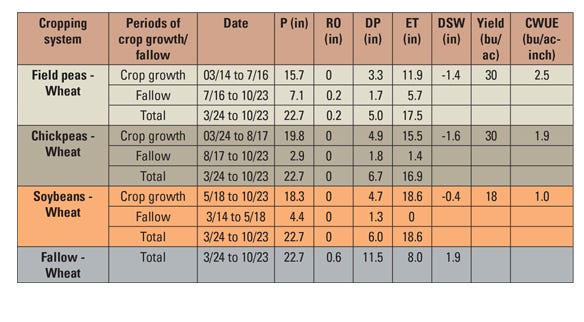March 7, 2019

Over the past 30 years, many dryland farmers in western Nebraska have replaced conventional tillage fallow with no-till chem-fallow to improve water conservation practices under wheat-corn-fallow or wheat-fallow rotations.
However, the long-term sustainability of fallow is becoming a challenge because of:
1. weeds evolving resistance to herbicides and forcing farmers to use summer tillage for weed control.
2. inefficient water use, soil degradation and reduction in soil organic carbon.
3. decline in wheat market prices and expenses to maintain fallow weed-free.
4. increase in expenses associated with state property taxes and cash rental rates for dryland cropland.
What are the alternatives?
Switching to continuous corn or replacing fallow with shorter season crops such as soybeans, field peas, chickpeas or proso millet eliminates the expenses associated with the fallow period. However, intensifying crop rotations often leads to less water being available to the subsequent crop in the rotation, often causing lower crop yield.
The objective of this project was to compare fallow with field peas, chickpeas and soybeans in terms of water balance, effect on next year’s wheat crop and profitability.
The predominant soil type at the demonstration plot at the Henry J. Stumpf International Wheat Research Center at Grant, Neb., was Kuma silt loam, and the previous crop was corn. The demonstration plot included side-by-side comparison of field peas, chickpeas, soybeans and fallow planted in 40-by-400-foot strips.
Seeding dates for field peas, chickpeas and soybeans were March 14, March 24 and May 17, respectively. Field peas, chickpeas and soybeans were harvested July 16, Aug. 17 and Oct. 23, respectively. The winter wheat crop was planted Oct. 23 across all four strips after soybean harvest.

TABLE 1: Yield (bushels per acre), Crop Water Use Efficiency (CWUE), precipitation (P), runoff (RO), deep percolation (DP), evapotranspiration/soil evaporation (ET) and soil water change (DSW) from March 14 to Oct. 23 for field peas, chickpeas, soybeans and fallow cropping systems. Source: UNL CropWatch

Water balance
Soil water balance. The difference in soil water profile (inches per 5-foot depth) at the beginning and end of the growing season was measured. Water losses in fallow because of runoff (0.6 inches), deep percolation (11.5 inches) and evaporation (8.0 inches) were much greater compared with fallow replacements, resulting 20.1 inches of total water loss (Table 1). However, fallow also was the only rotation that increased soil profile (5 feet) water storage by 1.9 inches over the course of the season (Table 1).
Deep percolation. Substantial DP losses were observed in all evaluated cropping systems because of above-average spring precipitation (6.5 inches higher than the 30-year average; Table 1). Among cropping systems, the largest DP was observed in fallow (11 inches) followed by chickpeas, soybeans and field peas, which had 6.7, 6.0 and 5.0 inches of DP, respectively. Growing field peas led to better use of spring precipitation and reduced water losses because of DP.
Soil evaporative losses. Fallow periods varied between the cropping systems causing different patterns in soil evaporative losses. While field peas were able to efficiently use early-season precipitation, a lack of plant cover during the hot and dry postharvest period (July 16 to Oct. 23, 7.1 inches) led to 5.7 inches of evaporative losses. One-month shorter postharvest periods of chickpeas (Aug. 17 to Oct. 23) cut evaporative losses in the chickpea-wheat cropping system to 1.4 inches. Finally, the cooler preseason fallow period of soybeans and no postseason fallow period resulted in no soil evaporative losses in soybeans.
Runoff. All cropping systems had very little runoff, because of good ground cover and relatively flat topography.
Crop Water Use Efficiency. Among the fallow replacements, field peas were the most water-use efficient crop, producing 30 bushels per acre with 11.9 inches of water (2.5 bushels per acre-inch). Next were chickpeas with a CWUE of 1.9 bushels per acre-inch, followed by soybeans, which produced only 18 bushels per acre using 18.6 inches of water (CWUE of 1.0 bushels per acre-inch).
Patterns in soil water extractions
Although field peas, chickpeas and soybeans had similar amounts of total available soil water at wheat planting, the soil water extraction patterns were quite different between fallow replacements. Field peas utilized water from soil depths below 3 feet during the grain-fill period in June and July but allowed for greater precipitation storage in the top 3 feet during the three-month postharvest fallow period.
Conversely, chickpeas and soybeans used most of the available water in the top 3 feet of the soil profile finishing off the crop during the summer months, thereby not reaching for water at depths more than 3 feet and not allowing enough time for precipitation storage in the top soil. Soil water storage in fallow was more than any fallow replacements, except in the top 6 inches, where water retention was reduced because of lack of residue cover.
Predicting next year's wheat crop
Previous research has suggested for every inch of water removed from the soil water profile by a crop and not replenished before wheat planting, a yield penalty of 4 to 6 bushels per acre may occur in the following wheat crop.
Compared with fallow, field peas, chickpeas and soybeans had 1.9, 1.9 and 2.3 inches less water, respectively, in the soil profile at wheat planting. So, if this water deficit isn't narrowed or eliminated during the winter, yield penalties of 8 to 12 bushels per acre can be expected in next year’s wheat crop.
Final evaluations on the system’s water balance and profitability will be completed after the winter wheat crop is harvested in July.
This report comes from UNL CropWatch, which is solely responsible for the information provided and is wholly owned by the source. Informa Business Media and all its subsidiaries are not responsible for any of the content contained in this information asset.
You May Also Like




